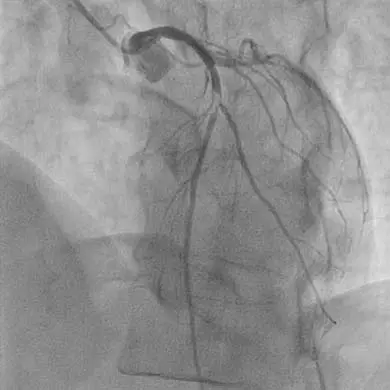Emergent Case With Comorbidities/Absorption Issues
Because timing & administration matter,
call on KENGREAL® (cangrelor).1
Semi-responsive patient with absorption issues
Not an actual patient—symptoms will vary; individual clinical evaluation should be conducted to determine the best course of therapy.
Presentation
- Developed chest tightness radiating to left arm while shoveling snow, followed by diaphoresis
- Symptoms persisted for 2 hours before 911 was called
- Semi-responsive 76-year-old male arrives at ED via ambulance
Medical history
- Type 2 diabetes mellitus; last A1c was 11.2%
- CKD stage 3
- Hyperlipidemia
- Controlled hypertension
- Height 177 cm; weight 97.7 kg; BMI 31
Exam and lab values
- EKG shows 1 mm of ST elevation in 2 contiguous leads
- Pulse 110 bpm; BP 90/55 mmHg
- Respiratory rate 22 breaths per minute
Antiplatelet history—No antiplatelet preload
Proximal left descending artery occlusion at the origin of the first diagonal branch

BMI= body mass index; BP=blood pressure; bpm=beats per minute; CKD=chronic kidney disease; ED=emergency department; EKG=electrocardiogram; IV=intravenous.
KENGREAL for a variety of patient scenarios
See other KENGREAL use cases.
STEMI Case Profile NSTEMI Case Profile See All Use CasesImportant Safety Information
KENGREAL® (cangrelor) for Injection is contraindicated in patients with significant active bleeding.
KENGREAL® is contraindicated in patients with known hypersensitivity (e.g., anaphylaxis) to cangrelor or any component of the product.
Drugs that inhibit platelet P2Y12 function, including KENGREAL®, increase the risk of bleeding. In CHAMPION PHOENIX, bleeding events of all severities were more common with KENGREAL® than with clopidogrel. Bleeding complications with KENGREAL® were consistent across a variety of clinically important subgroups. Once KENGREAL® is discontinued, there is no antiplatelet effect after an hour.
The most common adverse reaction is bleeding.
Please see Full Prescribing Information.
Indication
KENGREAL® (cangrelor) for Injection is a P2Y12 platelet inhibitor indicated as an adjunct to percutaneous coronary intervention (PCI) to reduce the risk of periprocedural myocardial infarction (MI), repeat coronary revascularization, and stent thrombosis (ST) in patients who have not been treated with a P2Y12 platelet inhibitor and are not being given a glycoprotein IIb/IIIa inhibitor.
References: 1. KENGREAL® (cangrelor) Prescribing Information. 2022. 2. Bhatt DL, Stone GW, Mahaffey KW, et al; CHAMPION PHOENIX Investigators. Effect of platelet inhibition with cangrelor during PCI on ischemic events. N Engl J Med. 2013;368(14):1303-1313. 3. Lawton JS, Tamis-Holland JE, Bangalore S, et al. ACC/AHA/SCAI guideline for coronary artery revascularization: a report of the American College of Cardiology/American Heart Association Joint Committee on Clinical Practice Guidelines. Circulation. 2022(45):e18-e114. 4. Byrne RA, Rossello X, JJ Coughlan, et al; ESC Scientific Document Group. 2023 ESC guidelines for the management of acute coronary syndromes. Eur Heart J. 2023;44(38):3720-3826.

